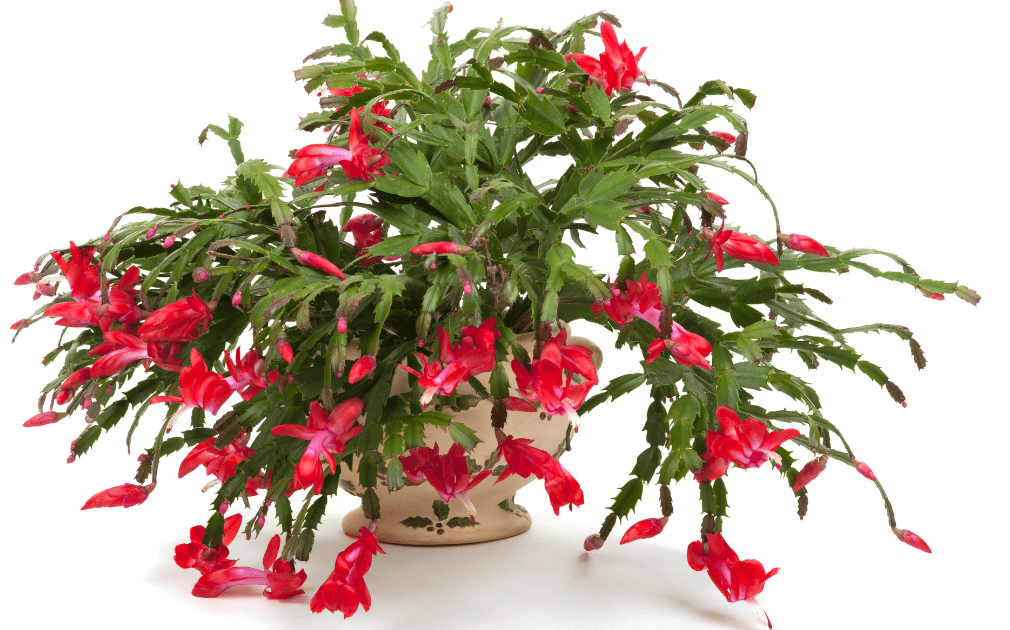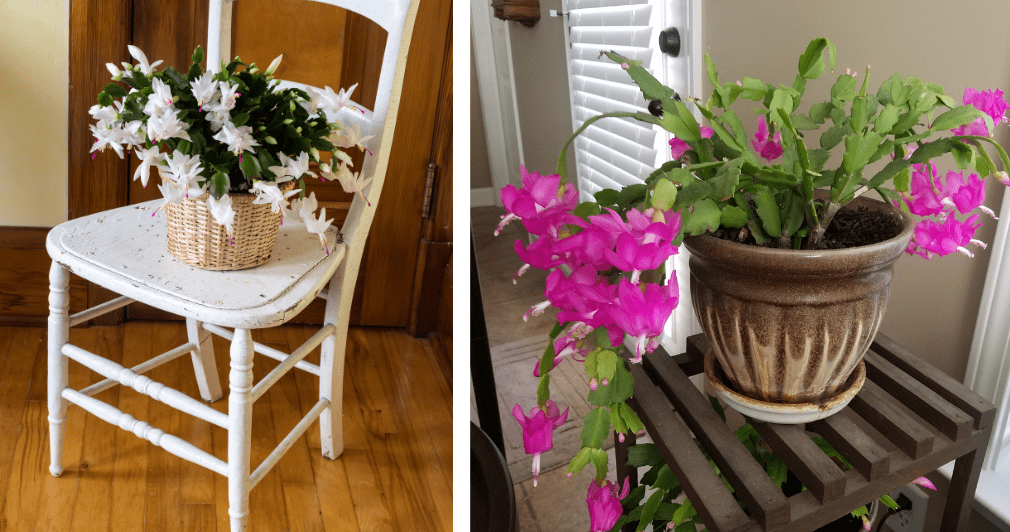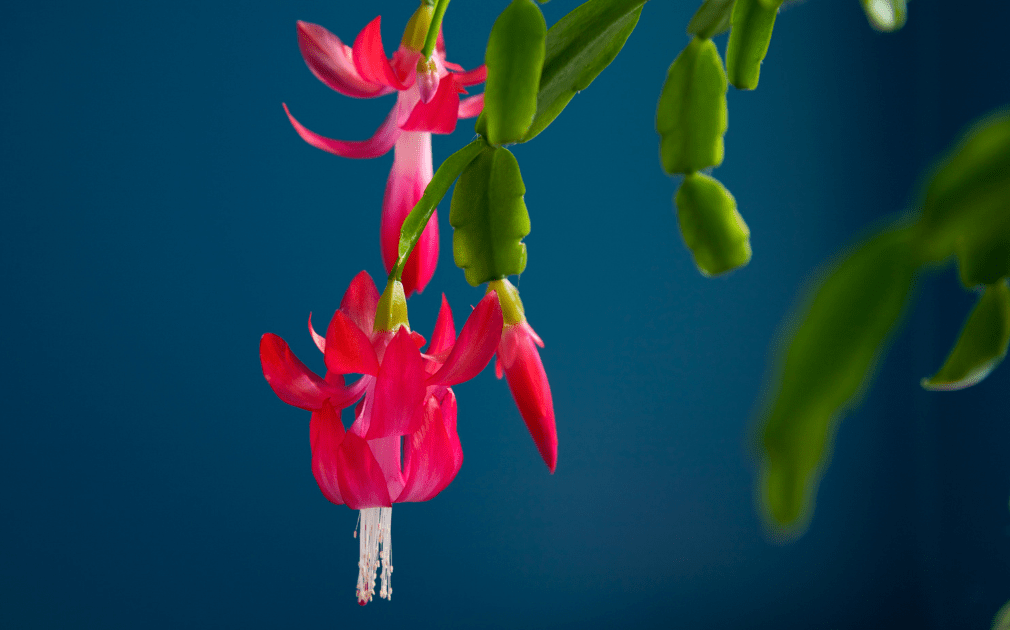Plants don’t often bloom when we tell them to, but ever since a friend gave me some instructions back in 1997, I’ve been able to get my amaryllis and Christmas cacti to bloom on demand. When I took the time to mark a few dates on my calendar and follow through, I got lovely blooms for the holiday season exactly when I wanted them. That little bit of knowledge piqued my interest, and I’ve done a bit of research since then. This post and the previous one convey what I’ve learned about amaryllis and Christmas cacti and controlling their bloom time.
Christmas cacti have been known to live 100 years when cared for properly! Both plants naturally grow in the spring and summer, and bloom in fall and winter, so we need to recreate those conditions if we want gorgeous flowers.
GENERAL CARE
Before we talk about blooming, we should talk about general care. Many people hear the word “cactus” and immediately think “hot sun,” and “dry soil.” In fact, the term “cactus”is a misnomer. This plant is an epiphyte (grows on trees) from the Brazilian rainforest, not a desert cactus. It doesn’t like blazing sun or dry soil. While Christmas cacti are pretty tolerant in terms of water and light amounts, if your cactus isn’t blooming, it’s a sign that you’re not quite treating it the way it wants to be treated.
- Light: Though Christmas cacti like a certain amount of light, a more indirect light will give you the best results. If the leaves start turning a bronze-ish red, it’s getting too much sun. This won’t hurt it in the long term, but if it’s putting energy toward healing a sunburn, it can’t put energy toward blooming.
- Temperature: Regular room temperature is about right; below 50F is too cold. The plant does not like cold or hot drafts, so pick your spot carefully.
- Water: Think of your Christmas cactus like a succulent when you’re watering—you want slightly plump leaves, not wrinkled. Keep the soil very slightly moist during the growing season and through the blooming season. After it blooms, you can back off on the watering a bit, but never let the pot dry out all the way. Water it twice a week during its growing season and in the winter just give it a light water every 10 days or so.
- Humidity: They like humidity, so if you’re running a humidifier in the winter see if there’s a good spot for your Christmas cactus in the room, or perhaps in your bathroom.
- Soil: When the soil needs refreshing, you’ll need a loose soil mix that retains water. Look for something a little acidic with some sand to allow drainage and some organic material to hold water. An orchid mix or Bromeliad mix is good, or 2 parts regular potting soil and 1 part perlite can work. Perch your pot on a saucer of pebbles to allow good drainage.
- Fertilizer: Give your plant a light feed of diluted houseplant fertilizer every month during their growing season but stop immediately when you notice it beginning to bud out in the fall. Hold off on fertilizing in the winter and start up again in the spring when it will begin growing again.
TIMING BLOOMS
Force dormancy: Start 8-10 weeks before Christmas (late September or October) to get from zero to full glorious blooms.
- Put your cactus in a place that gets natural light, but where you don’t have lamps on after dusk so it gets at least 12 hours of darkness each day.
- Reduce the temperature to around 60F. The ideal bloom temperature is 50-55F.
- Let the top layer of soil dry out.

Christmas cacti in natural, but not direct light
Waking up
- Your plant will decide how long to sleep. It will start to bud when it’s ready.
- When the cactus has set all its buds, put it back in its usual place and gradually ease back to your regular watering schedule.
- Pick the spot for your budded/blooming cactus carefully, because both cold and hot drafts will cause the plant to drop the buds. Think about heating vents, fireplaces/wood stoves, south-facing windows that heat up from the sun, leaky doors/windows, proximity to entry doors.
- During the bloom time, keep your cactus in a cooler spot in the room. The warmer the room, the shorter the lifespan of the blooms.
Repotting and propagation: Spring is the best time to repot. If you’ve noticed your plant has begun to dry out more quickly than before, it’s likely rootbound. If the leaves are yellowing or have black spots, you may be overwatering. Take your damp root ball out of the pot, trim off any rotted roots, divide it if needed, loosen those roots and put it in a slightly larger pot, surrounding the roots with fresh soil. If you want to expand your plant, take a few lengths of leaf segments and pop them around the edges of the pot.
Enjoy the blooms, and contact the Growline with any questions: SLCgrowline@gmail.com 
Juli Pomainville is a Master Gardener Volunteer who has been growing flowers and vegetables in Pierrepont since she was a child in 4-H. She enjoys experimenting with trendy gardening techniques, tending an annual flower garden for residents at a local nursing home, and teaching Seed to Supper classes for beginning gardeners.
